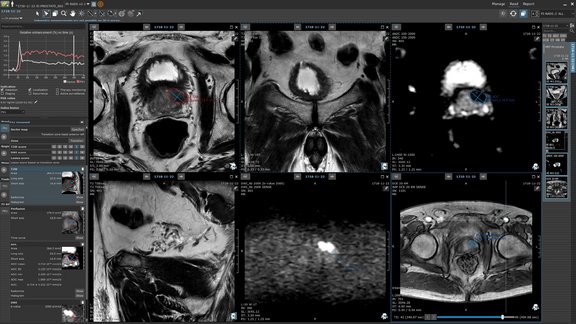When you’re working in diagnostic imaging, having the right medical imaging software can make the difference between a smooth workflow and daily frustration. We’ve compiled the top ten radiology software solutions that are revolutionizing how healthcare professionals handle diagnostic imaging today.
These powerful tools don’t just store images—they enhance diagnostic accuracy, streamline patient care, and help medical teams work more efficiently than ever before.
Why Quality Radiology Software Matters More Than Ever
Modern healthcare demands precision and speed. The right radiology software transforms raw medical images into actionable insights that save lives. Whether you’re managing a small clinic or a large hospital system, choosing the proper diagnostic imaging platform affects everything from patient outcomes to your bottom line.
Let’s explore the software solutions that are setting new standards in medical imaging.
1. Epic Radiology
Epic’s radiology module seamlessly integrates with their electronic health record system, creating a unified patient experience. You’ll appreciate how radiologists can access patient history, lab results, and imaging studies from one dashboard.
Key strengths: Complete EHR integration, robust reporting tools, and excellent workflow management capabilities.
2. GE Healthcare Centricity PACS
This comprehensive picture archiving system excels at handling large volumes of medical images. GE’s solution offers impressive storage capabilities and lightning-fast image retrieval that keeps your team productive.
Standout features: Advanced image processing, multi-site connectivity, and powerful analytics that help identify trends in diagnostic patterns.
3. Philips IntelliSpace PACS
Philips brings decades of medical imaging expertise to their software platform. Their solution shines in environments where multiple imaging modalities need seamless integration.
What sets it apart: Intuitive user interface, exceptional image quality optimization, and smart workflow automation that reduces repetitive tasks.
4. Siemens Healthineers syngo.via
This cloud-based platform transforms how radiology departments handle image analysis. Siemens focuses on making complex imaging accessible through simplified interfaces and powerful processing capabilities.
Notable advantages: Real-time collaboration tools, advanced 3D visualization, and AI-powered diagnostic assistance that enhances accuracy.
5. Fujifilm Synapse PACS
Fujifilm’s approach emphasizes user experience and reliability. Their software handles everything from routine X-rays to complex cardiac imaging with equal precision.
Why it works: Zero-downtime architecture, customizable workflows, and integration capabilities that adapt to your existing systems.
6. Agfa HealthCare Enterprise Imaging
Agfa’s platform excels at managing imaging across multiple departments and specialties. You’ll find their vendor-neutral approach particularly valuable in mixed-equipment environments.
Core benefits: Comprehensive image lifecycle management, strong security protocols, and scalable architecture that grows with your practice.
7. McKesson PACS
McKesson brings healthcare supply chain expertise to radiology software. Their solution focuses on operational efficiency and cost management while maintaining diagnostic excellence.
Primary strengths: Budget-friendly pricing models, reliable technical support, and straightforward implementation processes.
8. Carestream Vue PACS
Carestream’s web-based platform offers exceptional flexibility for modern radiology practices. Their software adapts well to both small clinics and large healthcare networks.
Key differentiators: Mobile accessibility, cloud deployment options, and user-friendly interfaces that reduce training time.
9. IBM Watson Imaging
IBM leverages artificial intelligence to enhance diagnostic capabilities. Their platform helps radiologists spot patterns and anomalies that might otherwise go unnoticed.
Innovative features: Machine learning algorithms, predictive analytics, and natural language processing for report generation.
10. Merge PACS (Now IBM)
This mature platform offers rock-solid reliability and comprehensive imaging management. Merge excels in environments where stability and proven performance matter most.
Proven advantages: Extensive interoperability, robust disaster recovery options, and time-tested workflow optimization.

Choosing the Right Solution for Your Practice
Selecting radiology software requires careful consideration of your specific needs. Consider factors like patient volume, imaging modalities, budget constraints, and integration requirements with existing systems.
Essential questions to ask:
- How many users will access the system simultaneously?
- What imaging equipment do you currently use?
- Do you need cloud-based or on-premise deployment?
- What’s your budget for implementation and ongoing maintenance?
The Future of Diagnostic Imaging Software
Radiology software continues evolving with artificial intelligence, machine learning, and cloud computing driving innovation. These technologies promise even greater diagnostic accuracy, faster processing times, and more intuitive user experiences.
Moving Forward
The right radiology software transforms your diagnostic imaging capabilities while improving patient care. Whether you choose an established platform like Epic or embrace AI-powered solutions like IBM Watson, focus on finding software that aligns with your practice’s unique requirements and long-term goals.
Remember: the best radiology software is the one that makes your team more effective while enhancing patient outcomes.


